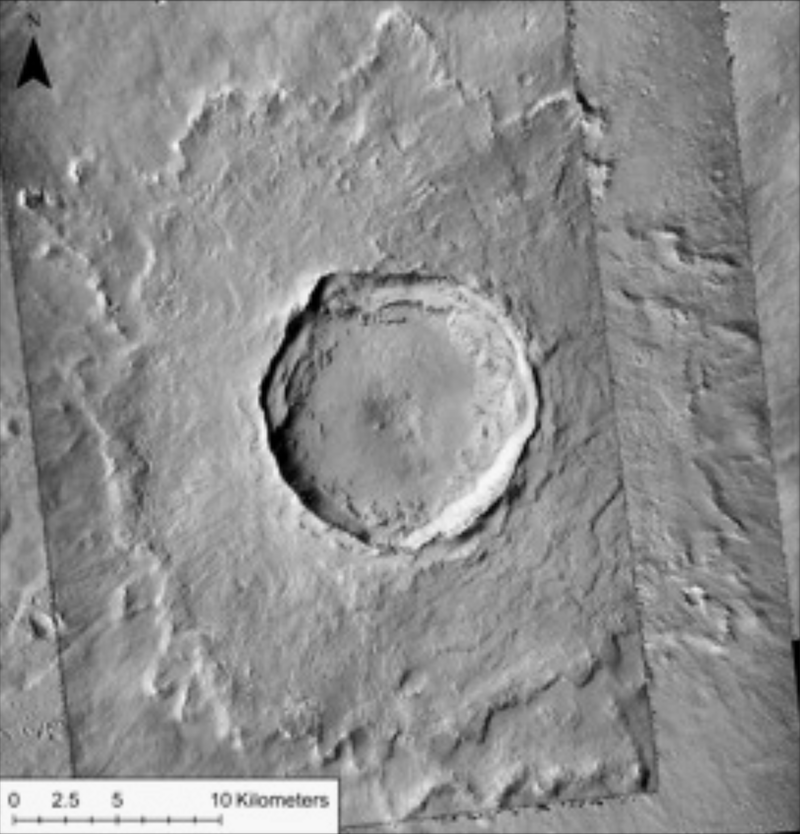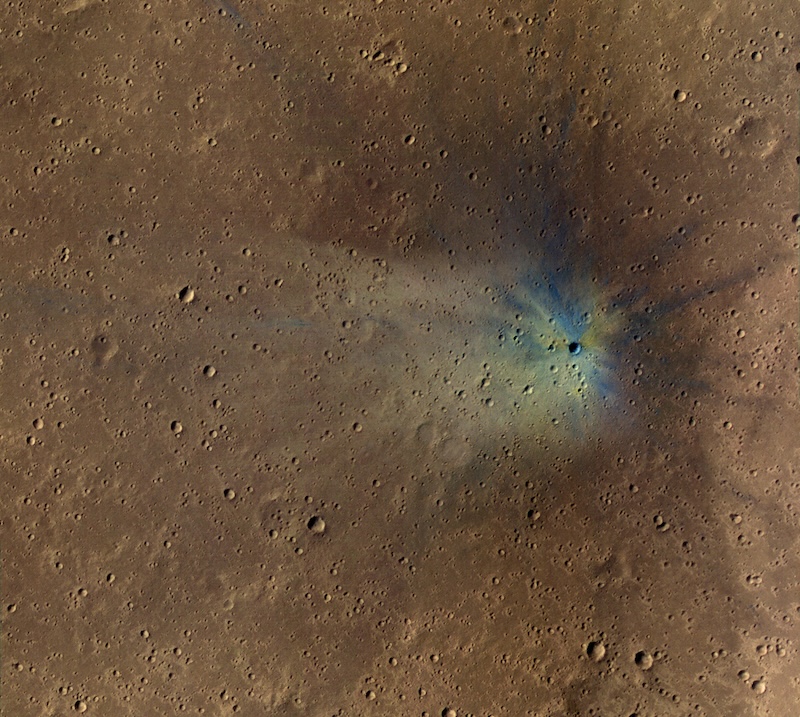
- About 2 million years ago, an asteroid hit Mars and created Corinto crater. A massive amount of smaller debris from the impact formed nearly 2 billion other, smaller craters on Mars.
- The debris created new, small craters as far as 1,200 miles (2,000 km) from the original asteroid impact site.
- Scientists determined the number of craters using imaging data from Mars Reconnaissance Orbiter.
1 asteroid = 2 billion craters
Some 2.3 million years ago – relatively recent in geologic time – a space rock careened toward Mars. It smashed into the Red Planet, hurling massive amounts of ejecta out of its newly formed crater. With no plate tectonics and little weathering, Mars still bears the scars of that impact today. Researchers counted the secondary craters formed from flying Martian rocks and dirt. Did they find hundreds? Thousands? Nope, the researchers found nearly two billion smaller craters! These craters are a minimum of 32 feet (10 meters) in size, lying up to 1,200 miles (2,000 km) from the main crater. The researchers presented their findings at the Lunar and Planetary Science Conference (LPSC 2024) in The Woodlands, Texas, in March.
You can read the new paper on the Universities Space Research Association (USRA) website.
A large impact crater and many smaller ones
The international team of researchers focused on a crater called Corinto, just north of the Martian equator in Elysium Planitia. Corinto is fairly large, about nine miles (14 km) across and 0.6 miles (one km) deep. So, when its parent asteroid hit Mars, it produced a lot of debris called ejecta. Secondary impacts created smaller craters both inside and outside the main crater.
The researchers used imaging data from the HiRISE and Context Camera (CTX) on the Mars Reconnaissance Orbiter (MRO) to study Corinto. The paper stated:
Orbital thermal and visible imaging datasets are used to describe the crater, ejecta blanket, four facies of rays and secondary craters, and to estimate the age of the impact and the total number of secondary craters.
The researchers examined five different kinds of craters around Corinto. Those five groups are what’s known as facies. Each group is distinct in appearance, largely due to how far away they are from Corinto crater. The craters closest to Corinto are semi-circular and have no ejecta of their own. They also have distinct rims. But some of the craters farther away are long and narrow looking.
Studies of the main crater also showed the ground was likely saturated with water ice. As a result, the superheated ice degassed during the impact.

Craters on Mars
Scientists calculated the angle of impact was about 30-45 degrees, with the asteroid coming from the north. Coming in from that northerly angle, most of the debris fell back to the surface to the south of the crater.
Consider the great distance from the main impact to the furthest craters, an incredible 1,200 miles (2,000 km) apart. It would be like an asteroid hitting Los Angeles and the debris reaching halfway across the United States to Dallas. What might it have been like to witness that impact and massive debris shower?
Bottom line: An asteroid created a large Martian crater called Corinto, about 2 million years ago. Debris from the impact also created 2 billion smaller craters on Mars.
Source: Corinto: A Young, Extensively Rayed Crater that Produced a Billion Secondaries on Mars
Read more: Giant volcano on Mars hiding in plain sight
Read more: Ancient volcanoes on Mars were diverse
The post How 2 billion craters on Mars were created by 1 asteroid first appeared on EarthSky.
from EarthSky https://ift.tt/9IbxXwf

- About 2 million years ago, an asteroid hit Mars and created Corinto crater. A massive amount of smaller debris from the impact formed nearly 2 billion other, smaller craters on Mars.
- The debris created new, small craters as far as 1,200 miles (2,000 km) from the original asteroid impact site.
- Scientists determined the number of craters using imaging data from Mars Reconnaissance Orbiter.
1 asteroid = 2 billion craters
Some 2.3 million years ago – relatively recent in geologic time – a space rock careened toward Mars. It smashed into the Red Planet, hurling massive amounts of ejecta out of its newly formed crater. With no plate tectonics and little weathering, Mars still bears the scars of that impact today. Researchers counted the secondary craters formed from flying Martian rocks and dirt. Did they find hundreds? Thousands? Nope, the researchers found nearly two billion smaller craters! These craters are a minimum of 32 feet (10 meters) in size, lying up to 1,200 miles (2,000 km) from the main crater. The researchers presented their findings at the Lunar and Planetary Science Conference (LPSC 2024) in The Woodlands, Texas, in March.
You can read the new paper on the Universities Space Research Association (USRA) website.
A large impact crater and many smaller ones
The international team of researchers focused on a crater called Corinto, just north of the Martian equator in Elysium Planitia. Corinto is fairly large, about nine miles (14 km) across and 0.6 miles (one km) deep. So, when its parent asteroid hit Mars, it produced a lot of debris called ejecta. Secondary impacts created smaller craters both inside and outside the main crater.
The researchers used imaging data from the HiRISE and Context Camera (CTX) on the Mars Reconnaissance Orbiter (MRO) to study Corinto. The paper stated:
Orbital thermal and visible imaging datasets are used to describe the crater, ejecta blanket, four facies of rays and secondary craters, and to estimate the age of the impact and the total number of secondary craters.
The researchers examined five different kinds of craters around Corinto. Those five groups are what’s known as facies. Each group is distinct in appearance, largely due to how far away they are from Corinto crater. The craters closest to Corinto are semi-circular and have no ejecta of their own. They also have distinct rims. But some of the craters farther away are long and narrow looking.
Studies of the main crater also showed the ground was likely saturated with water ice. As a result, the superheated ice degassed during the impact.

Craters on Mars
Scientists calculated the angle of impact was about 30-45 degrees, with the asteroid coming from the north. Coming in from that northerly angle, most of the debris fell back to the surface to the south of the crater.
Consider the great distance from the main impact to the furthest craters, an incredible 1,200 miles (2,000 km) apart. It would be like an asteroid hitting Los Angeles and the debris reaching halfway across the United States to Dallas. What might it have been like to witness that impact and massive debris shower?
Bottom line: An asteroid created a large Martian crater called Corinto, about 2 million years ago. Debris from the impact also created 2 billion smaller craters on Mars.
Source: Corinto: A Young, Extensively Rayed Crater that Produced a Billion Secondaries on Mars
Read more: Giant volcano on Mars hiding in plain sight
Read more: Ancient volcanoes on Mars were diverse
The post How 2 billion craters on Mars were created by 1 asteroid first appeared on EarthSky.
from EarthSky https://ift.tt/9IbxXwf

Aucun commentaire:
Enregistrer un commentaire